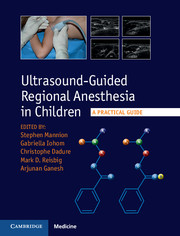Book contents
- Frontmatter
- Contents
- List of contributors
- 1 Introduction
- Section 1 Principles and practice
- 2 Performance of regional anesthesia in children
- 3 Pharmacology of local anesthetics in children
- 4 Management of complications of regional anesthesia
- 5 Basics of ultrasonography for regional anesthesia in children
- 6 Anatomy of the neuraxis, thoracic and abdominal walls, upper and lower limbs
- Section 2 Upper limb
- Section 3 Lower limb
- Section 4 Truncal blocks
- Section 5 Neuraxial blocks
- Section 6 Facial blocks
- Appendix: Muscle innervation, origin, insertion, and action
- Index
- References
2 - Performance of regional anesthesia in children
from Section 1 - Principles and practice
Published online by Cambridge University Press: 05 September 2015
- Frontmatter
- Contents
- List of contributors
- 1 Introduction
- Section 1 Principles and practice
- 2 Performance of regional anesthesia in children
- 3 Pharmacology of local anesthetics in children
- 4 Management of complications of regional anesthesia
- 5 Basics of ultrasonography for regional anesthesia in children
- 6 Anatomy of the neuraxis, thoracic and abdominal walls, upper and lower limbs
- Section 2 Upper limb
- Section 3 Lower limb
- Section 4 Truncal blocks
- Section 5 Neuraxial blocks
- Section 6 Facial blocks
- Appendix: Muscle innervation, origin, insertion, and action
- Index
- References
Summary
Introduction
The use of regional anesthesia for post-operative analgesia in children has gained popularity over time. While the caudal block is still the most commonly performed regional anesthetic technique in children, the performance of peripheral nerve blocks is growing. Advances in ultrasound technology have certainly contributed to the increase in the use of regional anesthetic techniques in children. The ability to view the anatomy and the use of real-time needle guidance has increased the confidence among anesthesiologists to perform a variety of regional anesthetic procedures in anesthetized children.
A successful regional anesthetic block requires adequate distribution of local anesthetic (LA) around the target neural structures (Marhofer et al., 2005). The ability to visualize the spread of LA adjacent to the neural structures has improved the success of regional anesthetic techniques. In addition, variations in anatomy can be recognized with the use of ultrasound, which in turn has the potential to increase the safety and success of regional anesthetic techniques.
This chapter describes the key principles necessary for performing safe and effective ultrasound-guided regional anesthesia in children – a number of the topics are considerably expanded on in subsequent chapters.
Anatomy and physiology
Chapter 6 describes the relevant anatomy for the blocks described in this book – below is a brief outline of the key anatomic differences between children and adults.
With regard to peripheral nerve blocks anatomic differences between children and adults may not be significant, although the smaller size of infants and children (structures are more superficial compared to adults) allow the use of higher frequency ultrasound probes resulting in a higher resolution image. However, one needs to appreciate the differences with neuraxial blockade. In a study using ultrasound guidance for epidural placement in children, the median value for the termination of the spinal cord was noted to be L2, but was as low as L3/L4 in some neonates (Willschke et al., 2007). Also, the dural sac in infants extends up to the S3 level. This is in contrast to adults where the spinal cord ends at the level of L1 and the dural sac at S1. Practitioners need to keep this in mind when performing neuraxial blockade in order to avoid injury to the spinal cord or an unintentional intrathecal injection.
- Type
- Chapter
- Information
- Ultrasound-Guided Regional Anesthesia in ChildrenA Practical Guide, pp. 5 - 12Publisher: Cambridge University PressPrint publication year: 2015



